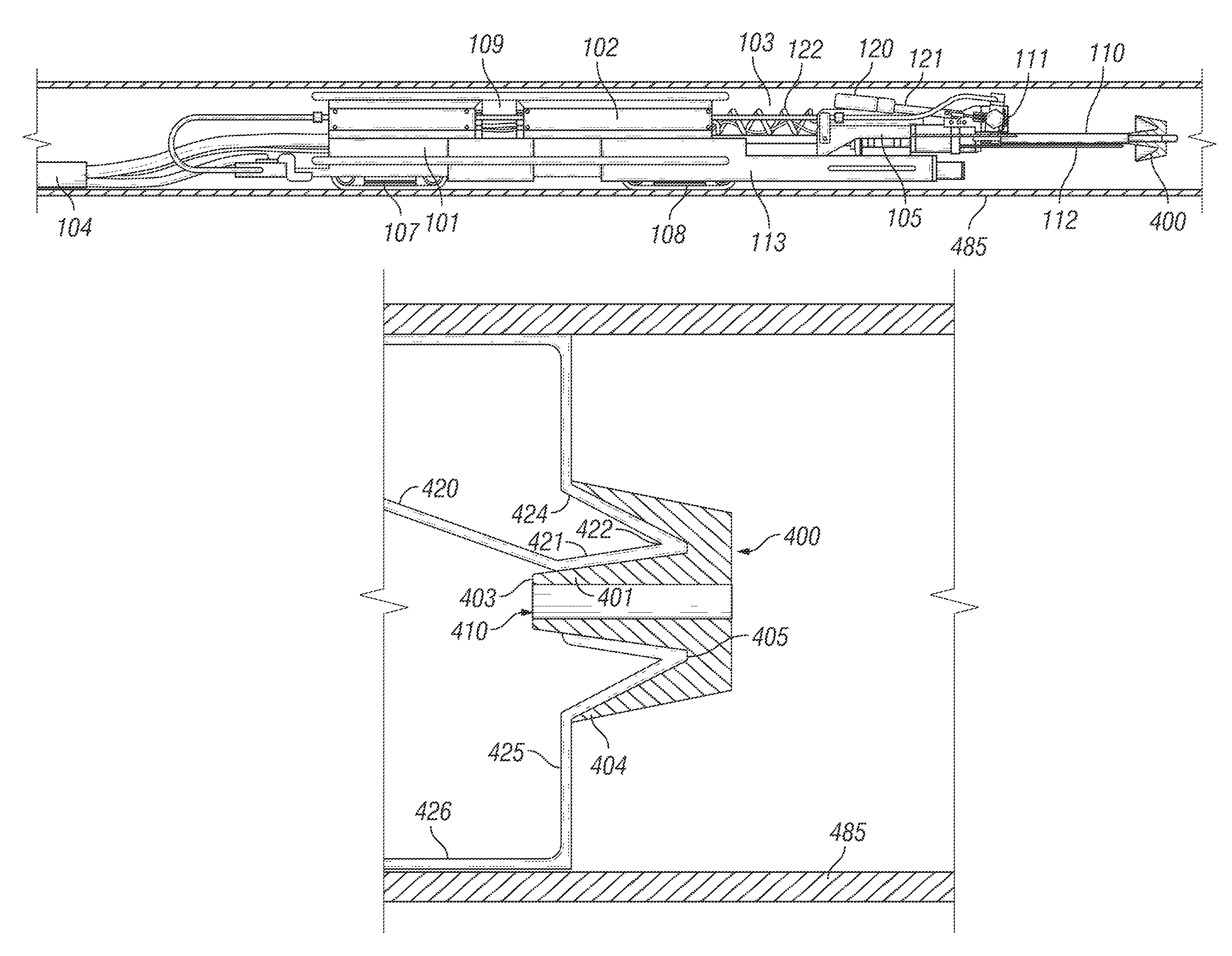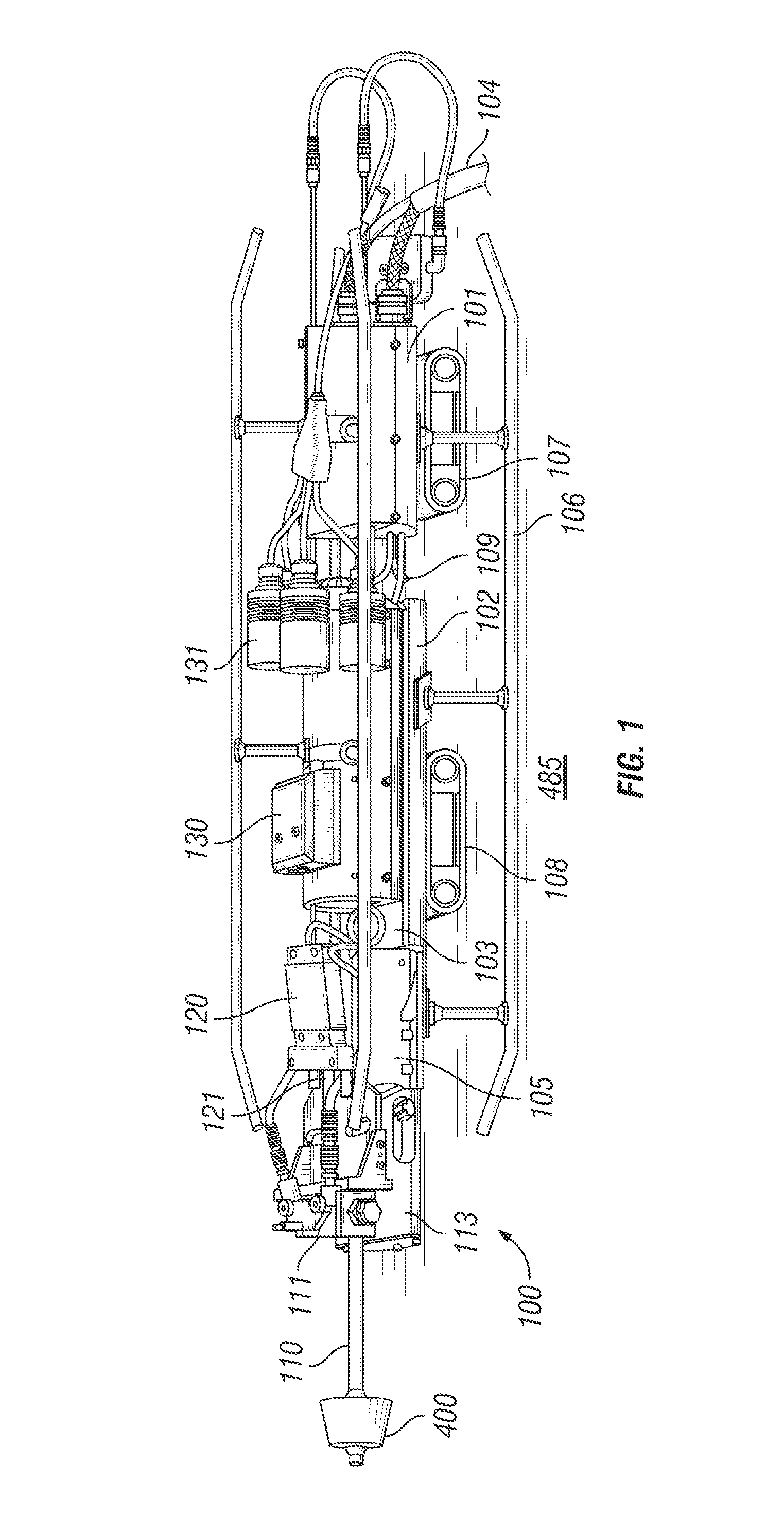There are many instances and conditions where the above methods are either not practical or are unsuitable.
A seamed monolithic liner is created by the inability of the lining method or apparatus to continuously line a section of
pipe.
As a result there are stop points in the lining and replacement lining overlaps the previously applied liner, thereby causing a seam.
Typical, prior art spray in type liners experience major problems as evidenced in the plugging of spray tips, slow curing coatings resulting in surface sags and inconsistent material application thickness and other constraints resulting in finished liner thicknesses in the 0.200-0.400 inch range, rendering them unsuitable for many applications.
The combination of these two assumed improvements actually result in a compounded problem.
Unfortunately adding air flow to the product
stream only increases the atomization of the spray resulting in higher static attraction to
moving parts.
Purging the spray tip with
compressed air does not eliminate the plugging problem.
This flat or slightly obliquely angled
spinning disc design as it relates to the direct right angle
diffusion of the spray causes a significant amount of rebounding / ricochet lining material to accumulate on the splatter shield and air blow off mechanism, ultimately resulting in total blockage of the tip and other crucial mechanical functions within a short period of time.
This does not allow for
continuous operation or lining of more than 10-20 feet of
pipe without the need to retract the apparatus and clean.
The
spinning disc design of Davis fails to satisfy the requirement for a uniform lining thickness as well.
As described, the
resultant physics do not afford equal dissipation of lining material in the full 360 degrees of circumference.
The current apparatus due to its flat or slightly oblique design does not afford the
coating material any dwell time to equalize
mass and distribute the
coating material around the circumference of the disc prior to being ejected.
This presents an unacceptable condition when uniformity is necessary to calculate ultimate liner properties and performance which is required by end users.
These formations will in time severely impede if not halt the apparatus' ability to continually line the pipe.
The build up of these formations will divert the flow from the tip to the spinner disc resulting in additional disproportionate distribution of
coating material to the pipe wall.
Formations that get imbedded in the uncured liner causing profiles in the flow channel that will result in diminished flow capacity of the liner due to increased
coefficient of friction.
Also the imbedded pieces causes “snag” areas in mixed
effluent pipelines such as
sewage which results in solids—
toilet paper etc—getting caught on them and building up sometimes to block pipeline flow.
This creates through voids in the finished liner.
This situation results in the need to remove the prior art apparatus from the pipe and clean many times to actually complete a full liner application hence diminishing the claims of a faster method in prior art.
Current art has an inherent design that has no way of stopping the build up of coating material on the spinner disc.
This does not allow the disc to totally disperse the lining material as the material does not have the weight and
mass needed to completely propel off the disc effectively.
The initial required rpm is then never fully achieved.
Hydraulic units work but the need to supply
hydraulic pressure at 500 feet requires bulking up the umbilical with hoses, adding costly pumps and additional weight and
diameter to the umbilical.
The above mentioned “dry fall” effect starts to gradually slow the rpm of the spinner disc due to the weight of the resulting build up.
As the rpm slows due to low torque, the effect becomes greater and greater having a “snowball” effect on the apparatus, completely stopping the spinner disc and ultimately rendering the apparatus incapacitated in as little as 10 minutes.
This results in the need to constantly remove the apparatus from the pipe and clean the shaft and disc which can take hours then reinserting to once again line for a short amount of time.
This consistent required retraction and
insertion can result in inter-coat de-lamination of the liner due to possible
contamination of the already installed liner while the retraction process and cleaning process is being completed.
This, however, is not possible in a single
insertion and retraction cycle.
This adds considerable time to the process evacuating any
advantage in time or economics over other lining methods as stated in prior art.
This design results in a straight
stream of dissipation off the spinner disc.
The prior art does not have the ability due to its design,
mechanics and straight or right angle stream to completely line the forward or backward edge of these profiles as it relates to the position of the apparatus.
Prior art also does not have the ability to reverse the rotation on the spinner disc.
In this instance there is no way that lining can be placed on the underside of this intrusion pipe or any profile for that matter without
counter rotation.
The reason for this is that on high rpm air motors they easily
wear out if they are run in both directions.
Compounding this problem in the prior art is that the unit does not have the ability to start and
stop flow.
Prior art design and
mechanics do not allow to open and close the valving rod or spray tip stopper more than one open and close cycle.
The prior art
mechanics does not have the
pull force or the ability to have a
momentum surge on the valving rod to break this free—hence the valving rod cannot be remotely opened up more than one cycle—open / close—done.
If not the result is heavy rings in the liner.
This design and mechanical flaw also does not allow the apparatus to complete sleeve or individual repairs in the pipe unless you do them one at a time due to the necessity to clean after every valving rod cycle.
Equipment of the prior art, due to its overall length, cannot be inserted or retracted from an underground pipe with the access being a manhole or vault with a
diameter or horizontal dimension or less than 5 feet.
This, however, does not afford this apparatus the ability to coat the entire pipe.
There is currently no acceptable way afterward to line this section that is void of lining material.
There is no way after this in a small diameter pipe to get in and manually line the pipe section that was missed.
Due to the design and mechanics of the prior art, it cannot be utilized in a pipe with a diameter of less than 10″.
The basic dimensions however do not allow for this as filed in the drawings.
Over and above the fact that the unit's dimensions
restrict its ability to line pipe with diameters less than 10″, its function of mechanics also severally impedes this ability.
This results in all oscillating parts to be on the exterior of the apparatus and in close proximity to the pipe wall.
In either case it causes a build up or “
ringing” in the new coating which is unacceptable.
This exposes them to all the overspray and existing contaminants that are in the pipe while being coated.
This eventually impedes their function resulting in diminished capabilities or incapacitation.
 Login to View More
Login to View More 


